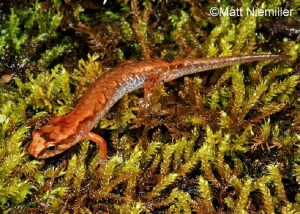Pygmy Salamander
The Pygmy (also Pigmy) Salamander, Desmognathus wrighti, is one of the smallest salamanders in TN. It is primarily restricted to higher elevations in the Blue Ridge Mountains along the Tennessee-North Carolina border. A small species (1.5 to 2.0 inches in length) with a dark herringbone pattern on the back over a reddish-brown to coppery-colored stripe. The sides of the body are silver-colored, and the eyelids are bronze. The belly is flesh-colored, and the tail is short and round in cross-section.
Similar Species: Seepage Salamanders have reddish-brown wavy or straight stripes along the back.
Habitat: Occurs beneath small logs, bark, stumps, moss, rotting litter, and stones in spruce-fir forests at high elevations (2750-6600 ft).
Diet: Soil mites, springtails, moths, beetles, flies, pseudoscorpions, thrips, and spiders.
Breeding information: Breeding occurs in both fall and spring. Female lays 3-10 eggs in headwater seepage areas along the bank and attend eggs. Hatching occurs in the fall, with the larval stage completely terrestrial.
Status in Tennessee: Pygmy Salamanders are considered imperiled and very rare in TN. In 1994, TWRA listed the Black Mountain Salamander as "In Need of Management." Populations are in jeopardy due to loss of habitat from logging activities, increased recreational development, and stream pollution.
Fun Facts:
- The most terrestrial of the Desmognathus salamanders, occurring at great distances from streams.
- Frequently climbs trees at night, probably foraging for insects.
Best places to see in Tennessee: Great Smoky Mountains National Park above 2750 ft elevation.

